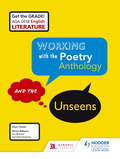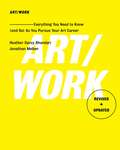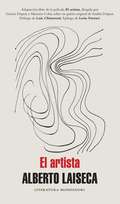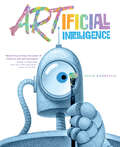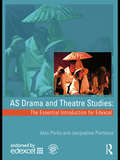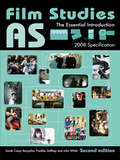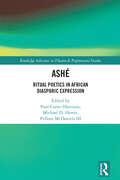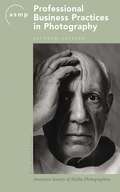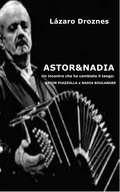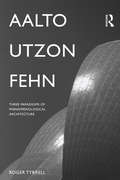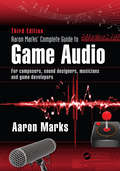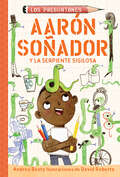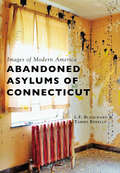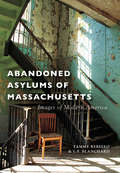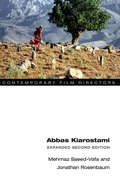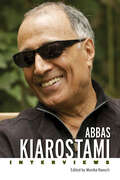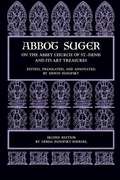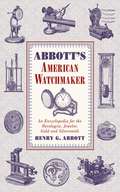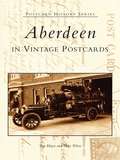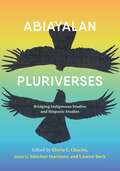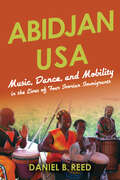- Table View
- List View
AQA GCSE (9-1) Design and Technology: Textile-Based Materials
by Bryan Williams Louise Attwood Pauline TreuherzBuild in-depth understanding and inspire your students to tackle design challenges both practically and creatively, with a textbook that delivers the Core Technical plus Specialist Technical and Design & Making Principles needed for the 2017 AQA D&T GCSE.The insight of our author team will build topic knowledge, including the technical principles of materials with which you are less familiar, while focusing on the specialist principles of textile-based materials in more depth, to ensure you can navigate the specification with confidence whilst your students' ideas flourish.· Trusted author team of specialist teachers and those with examining experience· Build topic knowledge with learning objectives directly linked to the specification and short activities to reinforce understanding· Develop mathematical and scientific knowledge and understanding with activities that link topics to maths and science· Inspire your students as they undertake the iterative design process, with examples of imaginative design-and-make tasks, and a look at how to approach the Non-Exam Assessment· Check knowledge and understanding with end of topic summaries and practice questions for the written exam
AQA GCSE English Literature Working with the Poetry Anthology and the Unseens Student Book
by Alan HoweSExam Board: AQALevel: GCSESubject: EnglishFirst Teaching: September 2015First Exam: June 2017upport your students in developing the skills required to understand and respond to every studied poem in the 2015 AQA Poetry Anthology- Teaches students how to analyse seen and unseen poems by moving gradually from first impressions to detailed explorations with thought-provoking questions at each stage- Provides approaches to learning all 30 poems in the AQA Anthology, including vital guidance for writing comparison answers- Ensures students are prepared for examination with a focus on the skills needed to succeed and how to tackle the different question types in Paper 2
ART/WORK: Everything You Need to Know (and Do) As You Pursue Your Art Career
by Heather Darcy Bhandari Jonathan MelberThe definitive, must-have guide to pursuing an art career—the fully revised and updated edition of Art/Work, now in its fourteenth printing, shares the tools artists of all levels need to make it in this highly competitive field.Originally published in 2009, Art/Work was the first practical guide to address how artists can navigate the crucial business and legal aspects of a fine art career. But the rules have changed since then, due to the proliferation of social media, increasing sophistication of online platforms, and ever more affordable digital technology. Artists have never had to work so hard to distinguish themselves—including by making savvy decisions and forging their own paths. Now Heather Bhandari, with over fifteen years of experience as a director of the popular Chelsea gallery Mixed Greens, and Jonathan Melber, a former arts/entertainment lawyer and director of an art e-commerce startup, advise a new generation of artists on how to make it in the art world. In this revised and updated edition, Bhandari and Melber show artists how to tackle a host of new challenges. How do you diversify income streams to sustain a healthy art practice? How can you find an alternative to the gallery system? How do you review a license agreement? What are digital marketing best practices? Also included are new quotes from over thirty arts professionals, updated commission legal templates, organizational tips, tax information, and advice for artists who don’t make objects. An important resource for gallerists, dealers, art consultants, artist-oriented organizations, and artists alike, Art/Work is the resource that all creative entrepreneurs in the art world turn to for advice.
ARTISTA, EL (EBOOK)
by Alberto Laiseca"Obra conjunta Alberto Laiseca, los hermanos Duprat, Mariano Cohn, León Ferrari, nada complaciente, El artista revela que sí, que la inspiración es posible: la belleza esquiva, inasible, la notación rápida, frugal, fugaz a lo Stendhal, el desenlace balzaciano. Es admirable que lo riesgoso adquiera un matiz gratificante, asombroso, pero es lo que ocurre en este caso: nos asomamos, nos aventuramos, y recibimos una recompensa a la altura de la curiosidad, de la expectativa. La vida oscurece las diferencias entre la vida y el arte, como pregonaba (o acaso sólo implorara) Cage, y una investigación seria sobre los valores y posibilidades del arte en la cultura actual puede despejarse del malestar inherente a las capillas y las jergas y resultar, a la vez, un entretenimiento amable, un relato entrañable." Luis Chitarroni
ARTificial Intelligence
by David BiedrzyckiEver since he was a little chip, Robot knew he was ART-ificially different. A funny and heartfelt picture book exploring AI, art, and creativity.Try as he might, Robot can't keep up with the other robots at the warehouse. But when he's sent off for reprogramming, he takes a wrong turn and ends up encountering music, dancing, and ART! He tries to share his discovery, only to find that art is hard to explain—and even harder to do. Will Robot learn to express himself and transform the warehouse . . . or will he be recycled?
AS Drama and Theatre Studies: The Essential Introduction for Edexcel
by Alan Perks Jacqueline PorteousAS Drama and Theatre Studies: The Essential Introduction for Edexcel is a comprehensive and accessible guide to the new specification. The textbook covers all aspects of the AS year in depth, from exploring play texts to demonstrating skills in performance and theatre design. The detailed guidance and classroom-friendly features include: overviews of specification and assessment requirements written and practical exercises tips from a Chief Examiner extension exercises to stretch the more able student worked examples to illustrate best practice a glossary of useful words and terms. Written by a Chief Examiner and a Principal Moderator, this authoritative book offers a wealth of informed and supportive exercises to ensure that students reach their maximum potential.
AS Film Studies: The Essential Introduction
by John White Freddie Gaffney Sarah Casey BenyahiaAS Film Studies: The Essential Introduction gives students the confidence to tackle every part of the WJEC AS level Film Studies course. The authors, who have wide ranging experience as teachers, examiners and authors, introduce students step by step, to the skills involved in the study of film. The second edition follows the new WJEC syllabus for 2008 teaching onwards and has a companion website with additional resources for students and teachers. Specifically designed to be user friendly, the second edition of AS Film Studies: The Essential Introduction has a new text design to make the book easy to follow, includes more than 100 colour photographs and is jam packed with features such as: Case studies relevant to the 2008 specification Activities on films including Little Miss Sunshine, Pirates of the Caribbean & The Descent Key terms Example exam questions Suggestions for further reading and website resources
ASHÉ: Ritual Poetics in African Diasporic Expression (Routledge Advances in Theatre & Performance Studies)
by Michael D. Harris Paul Carter Harrison Pellom McDaniels III‘ASHÉ: Ritual Poetics in African Diasporic Expressivity' is a collection of interdisciplinary essays contributed by international scholars and practitioners. Having distinguished themselves across such disciplines as Anthropology, Art, Music, Literature, Dance, Philosophy, Religion, and Theology and conjoined to construct a defining approach to the study of Aesthetics throughout the African Diaspora with the Humanities at the core, this collection of essays will break new ground in the study of Black Aesthetics. This book will be of great interest to scholars, practitioners, and students interested in tracing African heritage identities throughout the African Diaspora through close examination of a variety of discourses directly connected to expressive elements of cultural production and religious rituals.
ASMP Professional Business Practices in Photography
by American Society of Media PhotographersAt last! The eagerly anticipated revised edition of the photographer's "business bible" is here, fully updated with the last word on key business practices, industry standards, and resources. Up-to-the-minute coverage now includes digital asset management; metadata standards; the role of Internet, FTP, and e-mail technologies; the impact of media consolidation on assignment and stock photography; and much more. This indispensable guide covers the full range of business and legal questions that photographers might have, with comprehensive advice from the ASMP, the foremost authority in the field. In eleven in-depth chapters, more than two dozen industry experts explore pricing and negotiating, ethics, rights in traditional and electronic media, publishing, and much more. Business and legal forms, checklists, and an extensive cross-media bibliography make this the one reference book that deserves a place on every successful photographer's bookshelf.
ASTOR & NADIA
by Lázaro Droznes Silvia Gallico e Marco GallicoUn incontro che ha cambiato il tango: Astor Piazzolla e Nadia Boulanger. Testo teatrale che racconta l'incontro fra Nadia Boulanger e Astor Piazzolla, un evento che influenzò profondamente la vita del musicista e la storia del tango. Da giovane, il noto autore di "Adiós Nonino", "Libertango" e "Oblivion" abbandonò il tango e il "bandoneón" per studiare e comporre musica classica. L'incontro con la nota insegnante francese di musica Nadia Boulanger aiutò Piazzolla a riscoprire la sua passione e le proprie radici musicali, a trovare il proprio stile musicale e a rivoluzionare il tango argentino con nuove tecniche. Se non avesse incontrato Nadia Boulanger Piazzolla non sarebbe stato lo stesso e il tango non sarebbe quello che conosciamo oggi. Un viaggio incredibile di scoperta e di crescita.
Aalto, Utzon, Fehn: Three Paradigms of Phenomenological Architecture
by Roger TyrrellThis book examines the work of three seminal Nordic architects - Alvar Aalto, Jørn Utzon and Sverre Fehn - from a phenomenological perspective, utilising the methodology of 'paradigm' (or 'in the manner of''). Roger Tyrrell explains how the approach of each architect is defined by the three sub-frames of the paradigm: that of the ‘origin’ (arche), that of ‘revealing’ (techne), and that of ‘the poetic conjunction’, in order to gain a holistic understanding of the experiential or phenomenological predisposition of the three architects. Using this method the author describes the commonalties and distinctive qualities of the architecture and design methods of Aalto, Utzon and Fehn. The final chapter projects the intellectual heritage of the three protagonists into the contemporary world, examining the work of practices from the UK, Norway and the USA that each extend this particular way of making place.
Aaron Marks' Complete Guide to Game Audio: For Composers, Sound Designers, Musicians, and Game Developers
by Aaron MarksWhether trying to land that first big gig or working to perfect the necessary skills to fill a game world with sound, Aaron Marks’ Complete Guide to Game Audio 3rd edition will teach the reader everything they need to know about the audio side of the multi-million dollar video game industry. This book builds upon the success of the second edition with even more expert advice from masters in the field and notes current changes within the growing video game industry. The tools of the trade excerpts will showcase what professionals, like Marty O’Donnell, Richard Jacques and Tom Salta, use to create their work and to help newcomers in the field prepare their own sound studios. Sample contracts are reviewed within the text as well as helpful advice about contractual terms and negotiable points. These sample contracts can also be found as a downloadable zip for the reader’s convenience. Aaron Marks also explores how to set your financial terms and network efficiently along with examples of how projects can go completely awry and achieving the best results in often complicated situations. Aaron Marks’ Complete Guide to Game Audio serves as the ultimate survival guide to navigating an audio career in the video game industry. Key Features New, full color edition with a complete update of information. Added and expanded coverage of field recording for games, creating voiceovers, adaptive and interactive audio and other cutting edge sound creation and implementation techniques used within games. Update/Replacement of interviews. Include interviews/features on international game audio professionals New and expanded interview features from game composers and sound designers of every experience level such as Keith Arem, Bradley Meyer, Christopher Tin and Rodney Gates including many international professionals like Pasi Pitkanen, Henning Nugel and Christos Panayides. Expanded and updated game console coverage of the Wii, Wii U, Xbox 360, Xbox One, PS3 and PS4. Includes new scripting and middleware concepts and techniques and review of powerful tools such as FMOD and Wwise.
Aarón Soñador y la serpiente sigilosa / Aaron Slater and the Sneaky Snake
by Andrea Beaty¡Una nueva entrega de la exitosa serie de libros de capítulos cortos, Los Preguntones, protagonizada por Aarón Soñador, ilustrador! Fred, el cuidador del zoológico, ama las serpientes, pero su favorita es una serpiente verde muy pequeña llamada Vern. Vern es astuto y constantemente trata de esconderse en el almuerzo de Fred. Cuando Vern se escapa y va suelto por el zoológico, aterriza en la cabeza de un niño, ¡y ahí habrá un problema! Unos ciudadanos exigen que se deshagan de todas las serpientes y el alcalde cierra el zoo hasta que el Ayuntamiento decida qué se va a hacer. ¿Es Vern una amenaza? ¿Son las serpientes un peligro para la sociedad? ¿O un recurso valioso para todos? ¿Quién debería decidir esas cosas? Los Preguntones necesitan todo su talento para ayudar al cuidador del zoológico, pero al final, es el arte de Aaron el que aclara el camino.
Abandoned Asylums of Connecticut (Images of Modern America)
by L. F. Blanchard Tammy RebelloThis collection of photographs, history, and firsthand accounts gives readers a glimpse at the roots of mental health. These vignettes are born of the personal stories of those who worked at these facilities, those who were institutionalized, and their families. The authors took the time to listen to their stories and endeavored to understand their past and recognize how these events continue to influence the mental health industry today. Pictured throughout are the physical relics of the places--the now largely abandoned asylums of Connecticut--where these stories unfurled.
Abandoned Asylums of Massachusetts (Images of Modern America)
by L. F. Blanchard Tammy RebelloThis collection of photographs, history, and firsthand accounts gives readers a glimpse at the roots of mental health. These vignettes are born of the personal stories of those who worked at these facilities, those who were institutionalized, and their families. The authors took the time to listen to their stories and endeavored to understand their pasts and recognize how these events continue to influence the mental health industry today. Pictured throughout are the physical relics of the places--the now largely abandoned asylums--where these stories unfurled.
Abandoned Malls of America: Crumbling Commerce Left Behind
by Seph LawlessWhat happens when the symbol of commerce crumbles? This collection of nearly two hundred stunning yet melancholic photos captures the decline of one of the biggest symbols of American consumerism—the shopping mall. Seph Lawless, whom Huffington Post refers to as the &“master of the abandoned,&” details the dilapidated state of these buildings that were once thriving with people and merchandise, now left to rot and be overrun with plant and animal life. In Abandoned Malls of America, Lawless showcases haunting images of shopping malls from all across America, from his hometown of Cleveland, OH in the Midwest to Birmingham, AL in the South and all the way to Los Angeles, CA on the West Coast. Alongside these beautiful images are first-hand accounts from people who grew up going to these malls, reminiscing on the dually wistful and fond memories of their once-favorite local hangouts. These essays include anecdotes from actress Yvette Nicole Brown (Drake and Josh; Community; etc.), actor Justin Kucsulain (The Walking Dead), New Yorker investigative journalist Ronan Farrow, and more. In this follow-up to his previous book, Abandoned, &“artivist&” Seph Lawless continues his journey photo-documenting the America left behind in the throes of economic instability and overall decline. Abandoned Malls of America is a perfect read for those interested in photography, architecture, or just longing for a little bit of nostalgia.
Abandoned Manitoba: From Residential Schools to Bank Vaults to Grain Elevators (Abandoned Manitoba)
by VariousTravel with Gordon Goldsborough from Rapid City School to Mallard Lodge to Union Stockyards and many places in between as the author helps us reclaim some of our long-lost heritage. This full colour, richly illustrated book looks at abandoned sites around Manitoba, describing their features, what caused them to be abandoned, and what they tell us about the history of the province.
Abandoned: Hauntingly Beautiful Deserted Theme Parks
by Seph LawlessHuffington Post called him “a master of the abandoned”—and for good reason. The “artivist” known only as Seph Lawless has spent the last ten years photo-documenting the America that was left behind in the throes of economic instability and overall decline—decrepit shopping malls, houses, factories, even amusement parks. Through nearly two hundred gorgeous and elegiac photographs, Abandoned details Lawless’s journey into what was once the very heart of American entertainment: the amusement park. Lawless visits deserted parks across the country, capturing in stark detail their dilapidated state, natural overgrowth, and obvious duality of sad and playful symbolism. Previously self-published as Bizarro, this updated edition of Lawless’s photographic tribute to decaying American amusement parks contains new content and a new foreword. For the first time, the famed photojournalist Seph Lawless makes his moving work available in a stunning trade edition.
Abbas Kiarostami: Expanded Second Edition (Contemporary Film Directors)
by Jonathan Rosenbaum Mehrnaz Saeed-VafaBefore his death in 2016, Abbas Kiarostami wrote or directed more than thirty films in a career that mirrored Iranian cinema's rise as an international force. His 1997 feature Taste of Cherry made him the first Iranian filmmaker to win the Palme d'Or at Cannes. Critics' polls continue to place Close-Up (1990) and Through the Olive Trees (1994) among the masterpieces of world cinema. Yet Kiarostami's naturalistic impulses and winding complexity made him one of the most divisive--if influential--filmmakers of his time. In this expanded second edition, award-winning Iranian filmmaker Mehrnaz Saeed-Vafa and film critic Jonathan Rosenbaum renew their illuminating cross-cultural dialogue on Kiarostami's work. The pair chart the filmmaker's late-in-life turn toward art galleries, museums, still photography, and installations. They also bring their distinct but complementary perspectives to a new conversation on the experimental film Shirin. Finally, Rosenbaum offers an essay on watching Kiarostami at home while Saeed-Vafa conducts a deeply personal interview with the director on his career and his final feature, Like Someone in Love.
Abbas Kiarostami: Interviews (Conversations with Filmmakers Series)
by Monika RaeschThe cinephile community knows Abbas Kiarostami (1940–2016) as one of the most important filmmakers of the previous decades. This volume illustrates why the Iranian filmmaker achieved critical acclaim around the globe and details his many contributions to the art of filmmaking. Kiarostami began his illustrious career in his native Iran in the 1970s, although European and American audiences did not begin to take notice until he released his 1987 feature Where’s the Friend’s House? His films defy established conventions, placing audiences as active viewers who must make decisions about actions and characters while watching the narratives unfold. He asks viewers to question the genre construct (Close-Up) and challenges them to determine how to watch and imagine a narrative (Ten and Shirin). In recognition for his approach to the craft, Kiarostami was awarded many honors during his lifetime, including the top prize at the Cannes Film Festival in 1997 for Taste of Cherry. In Abbas Kiarostami: Interviews, editor Monika Raesch collects eighteen interviews (several translated into English for the first time), lectures, and other materials that span Kiarostami’s career in the film industry. In addition to exploring his expertise, the texts provide insight into his life philosophy. This volume offers a well-rounded picture of the filmmaker through his conversations with journalists, film scholars, critics, students, and audience members.
Abbot Suger On The Abbey Church Of St. Denis And Its Art Treasures
by Abbot Suger Gerda Panofsky-Soergel Erwin PanofskyThis revised edition incorporates the additions and corrections recorded by Erwin Panofsky until the time of his death in 1968. Gerda Panofsky-Soergel has updated the commentary in the light of new material, and the bibliography that she has prepared reflects the scholarship on St. -Denis in the last three decades. She has obtained some additional and more recent photographs, and the illustrations include a new ground plan and a new section of the chevet of the Abbey Church, both drawn under the supervision of Sumner McKnight Crosby.
Abbott's American Watchmaker: An Encyclopedia for the Horologist, Jeweler, Gold and Silversmith
by Henry G. AbbottBack in all its original prestige Abbott's American Watchmaker and Jeweler remains the ultimate resource for watchmaking and jewelry craftsmanship. No aspect of the trade goes uncovered in this distinctly American approach to these ancient processes, organized to be the perfect introduction to learning the tools, parts, and their uses, handed down for many generations.Here you'll find hundreds of drawings, descriptions, and diagrams of many kinds of escapements, complete directions for making staffs, techniques for cleansing, pickling, and polishing all kinds of metals, a full list of necessary terms, and much more.For years Abbott revised this unmatched work, consulting the best authorities to provide the most accurate and comprehensive text. Here is the final reference, straight from an era of dignified professionals and serious craftsmen.
Aberdeen in Vintage Postcards (Postcard History)
by Tom Hayes Mike WiesePlotted and planned as a crossroads town along the developing Milwaukee Railroad, Aberdeen, South Dakota was first settled in 1881. With the arrival of the railroad in 1882, Aberdeen flourished. It earned the nickname of Hub City, serving as a railroad junction and agricultural center. Aberdeen's ability to adapt to a changing economy has led to steady growth and has made it the third largest city in the state.Using more than 200 images, authors Tom Hayes and Mike Wiese take the reader on a historic tour of Aberdeen. Drawing on their immense postcard collection, they tell the story of this tight-knit community and the incredible people who are an integral part of its history.
Abiayalan Pluriverses: Bridging Indigenous Studies and Hispanic Studies
by Gloria ChacónAbiayalan Pluriverses: Bridging Indigenous Studies and Hispanic Studies looks for pathways that better connect two often siloed disciplines. This edited collection brings together different disciplinary experiences and perspectives to this objective, weaving together researchers, artists, instructors, and authors who have found ways of bridging Indigenous and Hispanic studies through trans-Indigenous reading methods, intercultural dialogues, and reflections on translation and epistemology. Each chapter brings rich context that bears on some aspect of the Indigenous Americas and its crossroads with Hispanic studies, from Canada to Chile. Such a hemispheric and interdisciplinary approach offers innovative and significant means of challenging the coloniality of Hispanic studies.
Abidjan USA: Music, Dance, and Mobility in the Lives of Four Ivorian Immigrants (African Expressive Cultures)
by Daniel B. ReedDaniel B. Reed integrates individual stories with the study of performance to understand the forces of diaspora and mobility in the lives of musicians, dancers, and mask performers originally from Côte d'Ivoire who now live in the United States. Through the lives of four Ivorian performers, Reed finds that dance and music, being transportable media, serve as effective ways to understand individual migrants in the world today. As members of an immigrant community who are geographically dispersed, these performers are unmoored from their place of origin and yet deeply engaged in presenting their symbolic roots to North American audiences. By looking at performance, Reed shows how translocation has led to transformations on stage, but he is also sensitive to how performance acts as a way to reinforce and maintain community. Abidjan USA provides a multifaceted view of community that is at once local, national, and international, and where identity is central, but transportable, fluid, and adaptable.

